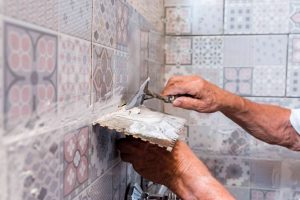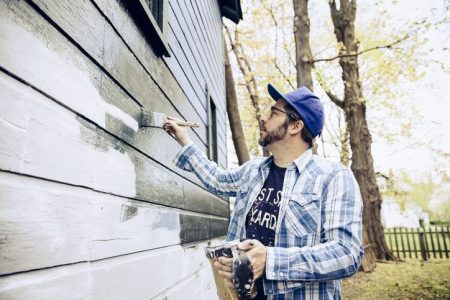One benefit of installing cedar siding is the beauty of its natural finish. Red cedar has a natural resistance to rot, decay, and insect attack.
Still, some homeowners may desire—or feel the need—for painting cedar siding. If you do, the coating system for red cedar siding with the longest expected service life is finished on all six sides with a stain-blocking primer and top coated with 100% exterior acrylic-latex paint. Factory-applied finishes of this type are available in most market areas where cedar siding is sold.
But installed cedar siding that is painted on one to four sides can still provide excellent protection.
Choose the Correct Type of Paint For the Cedar
Exterior grade acrylic-latex paint is the most dependable finish in terms of protecting cedar. The type of finish selected is driven by style preference. For many owners, painted cedar siding is a particular style; it is not all about protection. In many markets, like New England for example, painted siding is the preferred look. Beyond that, Western red cedar has multiple advantages over other cladding options because it is a natural and sustainable product.
For best results, fresh siding should be pre-primed on all six sides with a stain-blocking primer and top coated with 100% acrylic-latex paint. Alkyd-oil primers are recommended, but one may choose a high-quality latex primer as long as it contains stain blockers.
Prime the Cedar Before You Paint It
It is strongly recommended that you go with the two-coat system for protecting your cedar siding. One-coat paint is expressly not recommended for raw wood, weathered wood, dirty surfaces, or for wood that may have tannins. All of these conditions and possibly more describe average cedar wood siding.
A primer with a paint top coat will have a significantly longer service life than will a single coat of paint or even a solid stain. Paint applied to weathered wood without a primer will nearly always have adhesion issues.
Wood stained with oil or dirt must be thoroughly cleaned before priming. Primer is not designed to cover up contaminants. Oil-stained wood may have to be mechanically abraded. With cedar shingles, it’s sometimes best to replace oil-stained shingles than to try to sand them down, since oil soaks far into the wood.
Brush the Paint Rather Than Spray or Roll
Hand-brushing is recommended. For refinishing, especially, hand-brushing is always preferred. If one chooses to spray the paint on the cedar, the best results will be achieved by back brushing the finish during application.
With a porous material like cedar, the main idea is to apply a greater quantity of paint to the wood to allow the paint to soak into the porous wood. Hand-brushing is the best way to accomplish this. When spray painting cedar, prepare for multiple coats before the paint no longer soaks in.
Choose the Optimal Window of Time For Painting Cedar
Avoid painting the cedar within two weeks of installing it but do not wait too long (ideally, no more than 12 weeks) before painting it. With cedar, you have a narrow painting window.
A test at an experimental facility in Madison, Wisconsin involved a sample section of red cedar siding that was pre-primed on all six sides (including the ends), top coated with two coats of paint, and placed in a frame. The test section has never been re-coated and it shows no degradation of the coating system, though the test is over 25 years old.
Other samples were allowed to weather for three months, six months, nine months, and 12 months before being primed and painted. The longer the siding was allowed to weather, the sooner the coating system failed. And in all of those cases, it started to fail at the end grain where the siding abutted trim because the ends of the siding had not been primed.
Be Careful When Painting Very Old Cedar Siding
While extremely old cedar can be painted, it requires heavy preparation. Even then, the paint is not expected to last long.
Surface preparation is the key to success when dealing with weathered wood. The siding must be free from mold, mildew, and dirt. Loosened (photodegraded) surface fibers, and any loosened remaining finish must be removed prior to re-finishing.
Sanding is an option on smooth face siding, and commercial strippers/restorers are available to accomplish this task on more textured siding surfaces.
Choose Vertical Grain Cedar If Possible
Because of cell structure orientation, vertical grain cedar absorbs alkyd-oil stain-blocking primers better than flat grain cedar. However, knotty cedar holds these primers well because most knotty cedar siding patterns have a textured or re-sawn face.
Use a Two-Coat System Rather Than Self-Priming Paint
The Western Red Cedar Lumber Association has not seen any test data on self-priming paints. Factory finish warranties provided by primer and paint manufacturers apply to cedar siding that has one coat of primer and one or two top coats of paint.
In other words, most field tests that demonstrate the efficacy of painted cedar have been performed only on the two-part painting system of primer that is allowed to cure, followed by a separate coat of paint. If at all possible, favor the two-coat system over the one-coat system.
Paint Cedar Siding Frequently
Repaint cedar siding every five to seven years. Paint in ideal conditions can last as long as 10 years. Painted cedar siding in coastal areas should be painted more frequently due to harsh marine conditions. Areas that experience freezing cycles, too, can stress paint’s bond to the cedar.
Use High-Quality Primer and Paint
When shopping for primer and paint for cedar, choose high-quality materials. Use a heavy, stain-blocking primer on raw cedar. Follow with at least two coats of premium 100% acrylic-latex exterior paint. Never use oil-based paints with cedar.
Read the full article here














